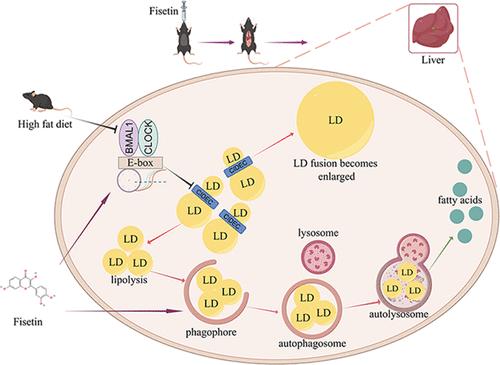Fisetin Ameliorates Hepatocyte Lipid Droplet Accumulation via Targeting the Rhythmic Protein BMAL1 to Regulate Cell Death-Inducing DNA Fragmentation Factor-α-like Effector C-Mediated Lipid Droplet Fusion
IF 6.2
1区 农林科学
Q1 AGRICULTURE, MULTIDISCIPLINARY
引用次数: 0
Abstract
High fat diet (HFD) induces the enlargement and accumulation of lipid droplets (LDs) in hepatocytes, thereby influencing the homeostasis of lipid metabolism. Cell death-inducing DNA fragmentation factor-α-like effector C (CIDEC), a surface protein of LDs, facilitates their fusion and growth, transforming small LDs into larger ones. Lipophagy, a selective form of autophagy, primarily targets small LDs for degradation. Fisetin (FIS), a natural dietary flavonoid present in various fruits and vegetables, has an unclear mechanism for reducing LD accumulation. In this study, we observed that FIS significantly ameliorated HFD-induced lipid accumulation in the hepatocytes of C57BL/6 mice. In further mechanistic studies, we revealed that FFA enhanced the expression of CIDEC, which promoted the fusion of LDs and caused them to become larger. The enlarged LDs could not be degraded by autophagy, which ultimately led to accumulation of LDs. Conversely, FIS alleviated LD accumulation by inhibiting CIDEC-mediated fusion, resulting in smaller LDs that facilitated lipophagy. Additionally, studies indicated that the dysfunction of circadian rhythms is closely related to lipid metabolism. In our study, we showed that HFD and FFA disrupted circadian rhythm in C57BL/6 mouse hepatocytes and AML12 cells, while FIS modified the rhythm disturbances and increased protein expression of the core clocks BMAL1 and CLOCK. We silenced the BMAL1 protein and revealed that si-BMAL1 upregulated CIDEC proteins. These data suggested that FIS might inhibit CIDEC-mediated LD fusion and enhance hepatocyte lipophagy by promoting the expression of rhythm protein BMAL1, thereby alleviating LD accumulation in C57BL/6 and AML12 cells caused by the HFD and FFA. The present study provided novel insights and potential targets for utilizing functional food factors to mitigate the accumulation of LD in hepatocytes.

菲赛汀通过靶向节律蛋白BMAL1调节细胞死亡诱导的DNA碎片因子-α样效应因子C介导的脂滴融合来改善肝细胞脂滴的积累
高脂饮食(HFD)会诱导肝细胞中脂滴(LDs)的增大和积聚,从而影响脂质代谢的平衡。细胞死亡诱导 DNA 断裂因子-α样效应物 C(CIDEC)是脂滴的一种表面蛋白,它能促进脂滴的融合和生长,使小的脂滴变成大的脂滴。脂噬是自噬的一种选择性形式,主要针对小 LDs 进行降解。鱼腥草素(FIS)是一种存在于各种水果和蔬菜中的天然膳食类黄酮,其减少低密度脂蛋白积累的机制尚不清楚。在这项研究中,我们观察到 FIS 能显著改善 C57BL/6 小鼠肝细胞中 HFD 诱导的脂质积累。在进一步的机理研究中,我们发现 FFA 可增强 CIDEC 的表达,从而促进 LD 的融合并使其变大。增大的 LDs 无法被自噬降解,最终导致 LDs 累积。相反,FIS 通过抑制 CIDEC 介导的融合,使 LD 变小并促进脂肪吞噬,从而缓解了 LD 的积累。此外,研究表明,昼夜节律失调与脂质代谢密切相关。在我们的研究中,我们发现 HFD 和 FFA 破坏了 C57BL/6 小鼠肝细胞和 AML12 细胞的昼夜节律,而 FIS 改变了节律紊乱并增加了核心时钟 BMAL1 和 CLOCK 的蛋白表达。我们沉默了 BMAL1 蛋白,发现 si-BMAL1 上调了 CIDEC 蛋白。这些数据表明,FIS 可能会抑制 CIDEC 介导的 LD 融合,并通过促进节律蛋白 BMAL1 的表达来增强肝细胞的噬脂性,从而缓解 HFD 和 FFA 在 C57BL/6 和 AML12 细胞中造成的 LD 累积。本研究为利用功能性食物因子减轻肝细胞中低密度脂蛋白的积累提供了新的见解和潜在靶点。
本文章由计算机程序翻译,如有差异,请以英文原文为准。
求助全文
约1分钟内获得全文
求助全文
来源期刊
CiteScore
9.90
自引率
8.20%
发文量
1375
审稿时长
2.3 months
期刊介绍:
The Journal of Agricultural and Food Chemistry publishes high-quality, cutting edge original research representing complete studies and research advances dealing with the chemistry and biochemistry of agriculture and food. The Journal also encourages papers with chemistry and/or biochemistry as a major component combined with biological/sensory/nutritional/toxicological evaluation related to agriculture and/or food.

 求助内容:
求助内容: 应助结果提醒方式:
应助结果提醒方式:


